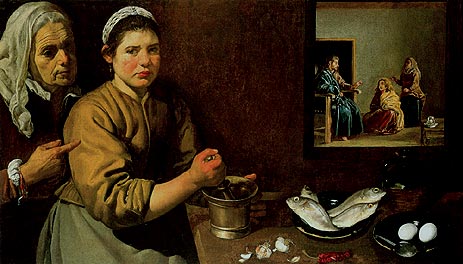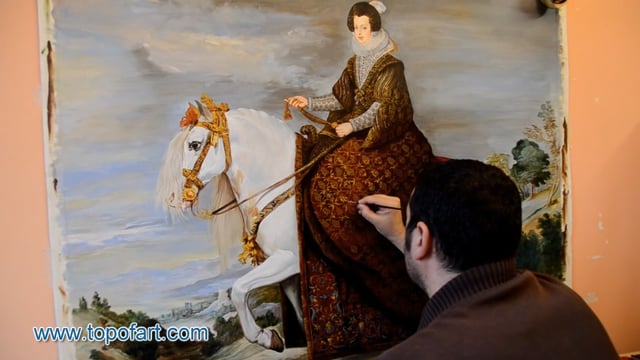Christ in the House of Martha and Mary, 1618 Diego Rodriguez de Silva Velazquez (1599-1660)
Location: National Gallery London UKOriginal Size: 60 x 103.5 cm


Recreating Velazquez: A Video Journey into Museum-Quality Reproductions by TOPofART
Video showcasing the process of hand-painting a Velazquez masterpiece with the utmost precision and care for detail.
Oil Painting Reproduction
If you want a different size than the offered
Description
Painted by European Аrtists with Academic Education
Museum Quality
+ 4 cm (1.6") Margins for Stretching
Creation Time: 8-9 Weeks
Creation Process
We create our paintings with museum quality and covering the highest academic standards. Once we get your order, it will be entirely hand-painted with oil on canvas. All the materials we use are the highest level, being totally artist graded painting materials and linen canvas.
We will add 1.6" (4 cm) additional blank canvas all over the painting for stretching.
High quality and detailing in every inch are time consuming. The reproduction of Diego Rodriguez de Silva Velazquez also needs time to dry in order to be completely ready for shipping, as this is crucial to not be damaged during transportation.
Based on the size, level of detail and complexity we need 8-9 weeks to complete the process.
In case the delivery date needs to be extended in time, or we are overloaded with requests, there will be an email sent to you sharing the new timelines of production and delivery.
TOPofART wants to remind you to keep patient, in order to get you the highest quality, being our mission to fulfill your expectations.
We not stretch and frame our oil paintings due to several reasons:
Painting reproduction is a high quality expensive product, which we cannot risk to damage by sending it being stretched.
Also, there are postal restrictions, regarding the size of the shipment.
Additionally, due to the dimensions of the stretched canvas, the shipment price may exceed the price of the product itself.
You can stretch and frame your painting in your local frame-shop.
Delivery
Once the painting Christ in the House of Martha and Mary is ready and dry, it will be shipped to your delivery address. The canvas will be rolled-up in a secure postal tube.
We offer free shipping as well as paid express transportation services.
After adding your artwork to the shopping cart, you will be able to check the delivery price using the Estimate Shipping and Tax tool.
Museum Quality
The paintings we create are only of museum quality. Our academy graduated artists will never allow a compromise in the quality and detail of the ordered painting. TOPofART do not work, and will never allow ourselves to work with low quality studios from the Far East. We are based in Europe, and quality is our highest priority.
Additional Information
In this case, Velazquez has painted the interior of a kitchen with two half-length women to the left. On the table are a number of foods, perhaps the ingredients of an Alioli (a garlic mayonnaise made to accompany fish). These have been prepared by the maid. Extremely realistic, they were probably painted from the artist's own household as they appear in other bodegones from the same time.
In the background is a biblical scene, generally accepted to be the story of Martha and Mary (Luke 10). In it, Christ goes to the house of a woman named Martha. Her sister, Mary, sat at his feet and listened to him speak. Martha, on the other hand, went to "make all the preparations that had to be made". Upset that Mary did not help her, she complained to Christ to which he responded: "Martha, Martha, ... you are worried and upset about many things, but only one thing is needed. Mary has chosen what is better, and it will not be taken away from her." In the painting, Christ is shown as a bearded man in a blue tunic. He gesticulates at Martha, the woman standing behind Mary, rebuking her for her frustration.
The plight of Martha clearly relates to that of the maid in the foreground. She has just prepared a large amount of food and, from the redness of her creased puffy cheeks, we can see that she is also upset. To comfort her (or perhaps even to rebuke her), the elderly woman indicates the scene in the background reminding her that she can not expect to gain fulfillment from work alone. The maid, who cannot bring herself to look directly at the biblical scene and instead looks out of the painting towards us, meditates on the implications of the story.
This is probably the most likely interpretation of the painting. However scholars have given other readings of it. Some have argued over the identities of the characters, suggesting that the maid in the foreground is actually Martha herself and the lady standing in the background is just an incidental character.
Another point of contention is over the representation of the background. On one hand, we may be looking at a mirror or through a hatch at the biblical scene. If so, it would imply that the whole painting, foreground and background, is set in Christ's time and would perhaps lend weight to the argument that the maid in the foreground is Martha. On the other hand, the biblical scene may just be a painting which is hung in the maid's kitchen. Given that the bodegones usually represent images of contemporary Spain, many have thought that this is probably the most likely explanation. However, the National Gallery say that following cleaning and restoration in 1964, it is now clear that the smaller scene is framed by a hatch or aperture through the wall. The suggestion of other possibilities, especially that of the scene as a painting, may remain as an element in the meaning of the work.
Whatever the truth of this is, we can appreciate this as an early example of Velazquez's interest in layered composition, a form also known as "paintings within the painting". He continually exploited this form throughout his career. Other examples of this are Kitchen Scene with the Supper in Emmaus (1618), Las Hilanderas (1657) and his masterpiece Las Meninas (1656).
There is a second version of the painting, with significant differences, in an American collection.
This work may demonstrate the influence of Flemish art. A painting which also shows a contemporary kitchen scene (albeit presented in a completely different way) with Christ, Martha and Mary in the background is The Four Elements: Fire, painted by Beuckelaer in 1570. It is possible that Velazquez had access to an engraving of this work.




